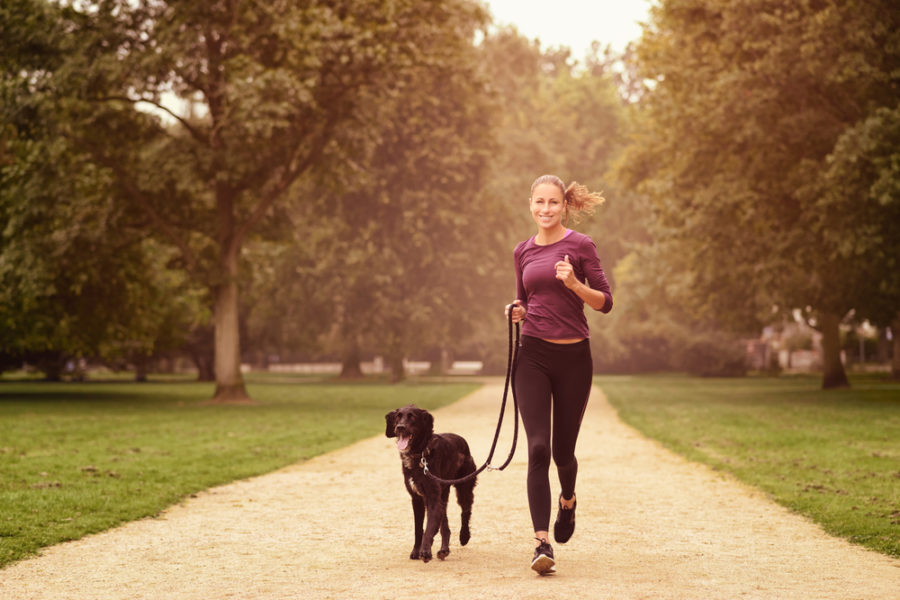Breed, size, age and health status all play a role in how much physical activity your dog requires to stay fit, happy and healthy.
Exercise is essential for your dog’s well-being. But it’s not a “one-size-fits-all” field. The appropriate type and amount of exercise depends on his breed or mix of breeds, but also on his size, age and physical health. Without considering all these factors, your dog may end up getting too little or too much exercise. It’s important to understand your individual dog when determining how much physical activity he needs to stay happy and healthy.
1. Breed type and exercise
Some dogs were bred for higher levels of activity because they worked with humans to hunt, herd or protect. These breeds often need more exercise than others, whether it’s through running, playing fetch, swimming or engaging in a canine sport like agility. “German shepherds, golden retrievers, pit bulls and most terriers are some of the most active breeds,” says dog trainer Elissa Weimer. Dogs with these breeds in their makeup crave activity and will run around the backyard just for enjoyment. “You can also teach them play hide and seek, do agility, or engage in nosework to keep it exciting,” Elissa says.
“German shepherds, golden retrievers, pit bulls and most terriers are some of the most active breeds.”
Not all breeds require a lot of physical activity. “Maltese, Chihuahuas and Bichons are examples of dogs that require less exercise,” says Elissa. Others include pugs, bulldogs, Basset hounds and Pekingese. These dogs benefit more from light activities such as a leisurely stroll – and in some cases, you might have to encourage them to do even that since getting off of the couch may not be one of their primary goals!
2. Size matters when it comes to exercise
It’s easy to assume that big dogs need more exercise, and smaller ones need less. Sometimes the two go hand-in-hand, but it’s not a rule. For example, great Danes are huge, but their exercise requirements are significantly lower than that of smaller breeds such as the border collie. And while greyhounds are associated with speed, they don’t need the same levels of physical activity as most terriers.
When a large dog and a small dog run a mile, the experience is difference for each. “Smaller dogs are effectively running longer distances from a physiologic standpoint,” says veterinarian Dr. Doug Knueven. This may seem obvious, but it means that even an extremely active but tiny canine may not need a great deal of exercise to meet his energy level requirements. Conversely, of course, a very active large-sized dog might require a lengthy run to make sure he gets the exercise he needs.
Another important size-related aspect is the dog’s weight. “Animals that are overweight need to exercise, but don’t overdo it,” says Dr. Knueven. “These dogs have more of a burden to carry, and might have reduced heart and lung function due to interference from the extra fat tissue,” If a dog is too heavy (or too thin), it is essential to work with a veterinarian to evaluate him before engaging him in an exercise program.
3. Additional considerations affecting exercise
Finding the proper amount and type of exercise for a dog is paramount to preventing behavioral problems as well as keeping him fit. “When dogs that need high levels of activity don’t get it, behavioral problems often result,” says Dr. Knueven. “They might take out their frustrations on furniture and carpeting.” This is because a dog can experience profound psychological discomfort when he doesn’t get the right amount of exercise. “It’s not fair to expect an intelligent active animal to behave when cooped up in a boring house all day with nothing to do.”
Elissa agrees: “All too often I see good-hearted owners who get a working or herding dog and expect him to just lounge around the house all day without causing chaos. It’s best to engage these dogs while exercising them so they are both mentally and physically drained.”
Physical problems, including those that are breed-related, may become more apparent with exercise. For example, short-nosed breeds like pugs often develop respiratory problems that can be exacerbated with too much physical activity. Illnesses such as cancer and neurological conditions can also influence how much exercise a dog should get; it’s important to work with your vet in these instances.
Age will affect how much exercise a dog needs. “As dogs get older, their need for exercise does not disappear, but it does diminish,” says Dr. Knueven. “Age often brings arthritis, for example, which may go undiagnosed unless the animal has obvious lameness.”
It’s essential to carefully monitor your dog before, during and after exercise, especially as he gets older. “If your dog is especially stiff or has difficulty getting up from a prone position after exercise, then cut back on the intensity of the workout and have her joints checked by a veterinarian,” Dr. Knueven says.
How much exercise is too much?
Ensuring active dogs get enough exercise is important, but you also have to be careful they don’t do too much. “Over-exercising a dog can lead to soreness, fatigue and even injuries if the animal is pushed to do more than his body can handle,” says Dr. Knueven.
Make sure your dog rests when he’s tired. “Some breeds, especially Labrador retrievers, can be obsessive about playing fetch and will literally chase the ball until they pass out,” adds Dr. Knueven. Be aware that dogs don’t always do what’s best for their well-being, and that you may need to intervene if your dog is overdoing it. “Use common sense when using fetch as a workout. Caution is also needed during warm weather as over-exercising can lead to heatstroke.”
By properly researching your dog’s breed or mix of breeds, considering his size, and factoring in any physical or behavioral issues, you and your vet can build the best possible exercise problem for your best friend’s wellness and longevity.







